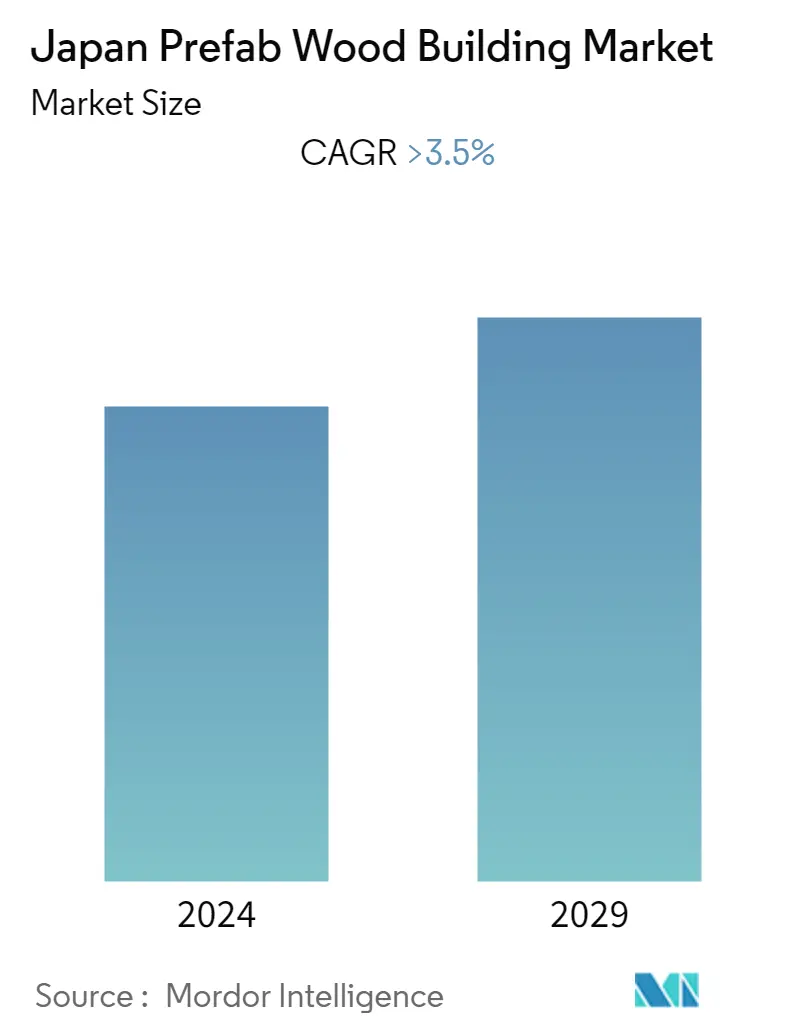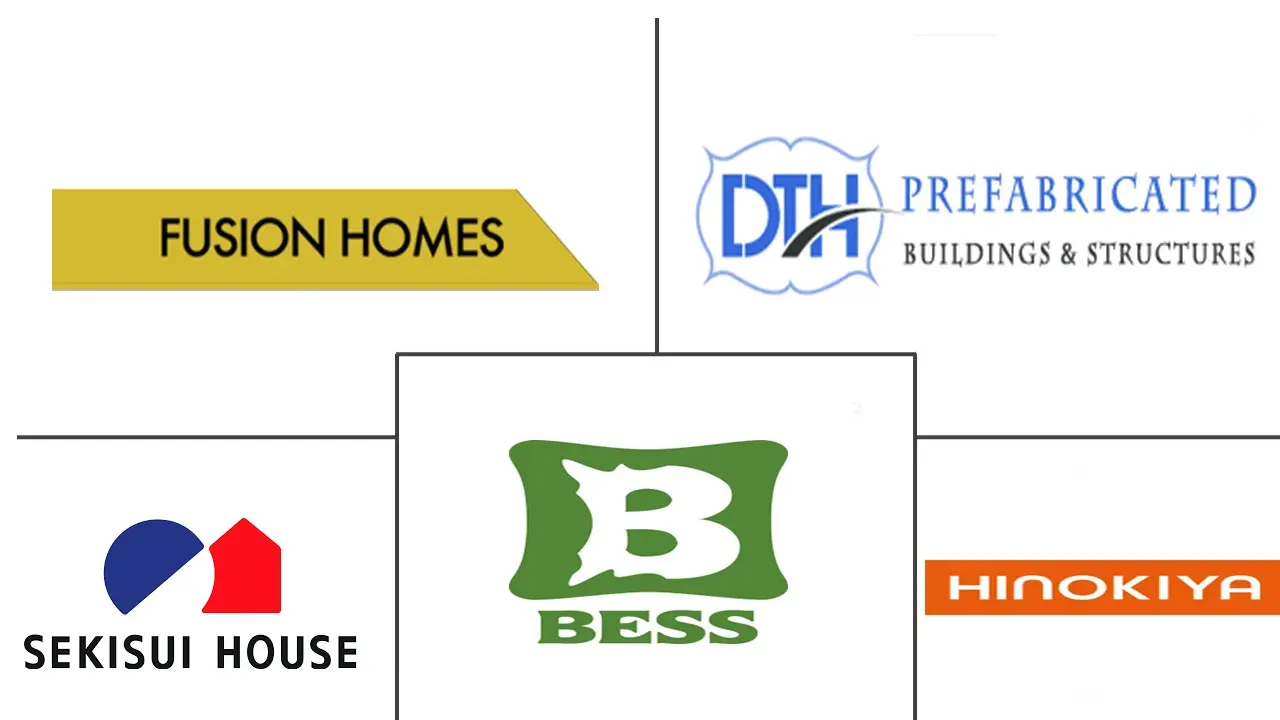Market Size of Japan Prefab Wood Building Industry

| Study Period | 2020 - 2029 |
| Base Year For Estimation | 2023 |
| Forecast Data Period | 2024 - 2029 |
| Historical Data Period | 2020 - 2022 |
| CAGR | 3.50 % |
| Market Concentration | Medium |
Major Players
*Disclaimer: Major Players sorted in no particular order |
Japan Prefab Wood Building Market Analysis
Japan Prefab Wood Building Market is expected to register a CAGR of over 3.5% during the forecast period of 2023-2028.
- With efficient manufacturing methods, focused marketing tactics and consumer engagement, and high-quality designs that offer diversity and flexibility at accessible rates, Japan's prefabricated-housing business is a world leader in innovation. Clients may personalize their homes with standardized components using a completely automated system. Unlike the popular Western impression of prefabrication, factory-manufactured houses are seen as better than conventionally constructed ones in Japan.
- The broad system for mass customisation, with a high level of user input throughout the process, is a key element of Japanese prefab housing. Manufacturers employ a modular production strategy, focusing on a custom design for each unit while mass-producing a range of housing components for clients to pick from. This strategy is crucial for meeting the different needs of homebuyer demographics while also reducing costs through mass manufacturing and economies of scale.
- Traditional wooden houses built by small builders are rarely in direct competition with prefabricated houses built by major manufacturers, although there is strong competition among buildings built by huge corporations using any building technique.
Japan Prefab Wood Building Industry Segmentation
Prefabricated wood construction kits, similar to life-sized Legos, are constructed out of prefabricated components that are supplied and installed on-site. This is most commonly accomplished by the use of prefabricated panels that may create complete portions of a building, such as roofing components or structure (ceiling, decking, and beams), building structure (wall panels, beams, columns, and shear paneling), and even glazing packages.
The market is segmented By Panels (Cross-laminated timber (CLT) panels, Nail-laminated timber (NLT) panels, Dowel-laminated timber (DLT) panels, and Glue-laminated timber (GLT) columns and beams), and By Application (Residential, Commercial and Other Applications ( Industrial, Institutional, and Infrastructure)).
The report offers market size and forecasts for Japan Prefab Wood Building Market in value (USD Billion) for all the above segments. The report also covers the impact of COVID-19 on the market.
| By Panel Systems | |
| Cross-laminated timber (CLT) panels | |
| Nail-laminated timber (NLT) panels | |
| Dowel-laminated timber (DLT) panels | |
| Glue-laminated timber (GLT) columns and beams |
| By Application | |
| Residential | |
| Commercial | |
| Other Applications ( Industrial, Institutional, and Infrastructure) |
Japan Prefab Wood Building Market Size Summary
The Japan Prefab Wood Building Market is characterized by its innovative approach to prefabricated housing, leveraging efficient manufacturing methods and high-quality designs that offer customization and flexibility at competitive prices. This market is a global leader in the adoption of advanced prefabrication techniques, where factory-manufactured homes are often perceived as superior to traditional construction methods. The Japanese market employs a modular production strategy, allowing for mass customization while maintaining cost efficiency through economies of scale. This approach caters to diverse consumer needs and preferences, setting Japan apart from other regions like the UK, where similar industrialization efforts have not yet achieved comparable results in terms of consistency, efficiency, and customer satisfaction.
The market is semi-consolidated, with significant players like Panasonic Homes and Toyota Home entering the wooden housing sector, alongside local builders gaining influence. The trend towards mid-rise wooden structures is supported by legislative changes promoting the use of domestic timber, with notable projects such as Mitsui Home's rental apartment complex and Nomura Real Estate Development's hybrid condominium setting new standards. The market dynamics are shaped by strategic mergers, acquisitions, and technological advancements, as companies like Sekisui House expand internationally, despite challenges in markets like the UK. This ongoing industrialization and expansion reflect Japan's commitment to enhancing its prefab wood building sector, maintaining its position as a frontrunner in the global market.
Japan Prefab Wood Building Market Size - Table of Contents
-
1. MARKET INSIGHTS AND DYNAMICS
-
1.1 Market Overview
-
1.2 Market Drivers
-
1.3 Market Restraints
-
1.4 Value Chain / Supply Chain Analysis
-
1.5 Industry Attractiveness - Porter's Five Force Analysis
-
1.5.1 Threat of New Entrants
-
1.5.2 Bargaining Power of Buyers/Consumers
-
1.5.3 Bargaining Power of Suppliers
-
1.5.4 Threat of Substitute Products
-
1.5.5 Intensity of Competitive Rivalry
-
-
1.6 Government Regulations and Initiatives
-
1.7 Technological Trends
-
1.8 Brief on Different Structures Used in the Prefabricated Buildings Industry
-
1.9 Cost Structure Analysis of the Prefabricated Buildings Industry
-
1.10 Impact of COVID-19 on the Market
-
-
2. MARKET SEGMENTATION
-
2.1 By Panel Systems
-
2.1.1 Cross-laminated timber (CLT) panels
-
2.1.2 Nail-laminated timber (NLT) panels
-
2.1.3 Dowel-laminated timber (DLT) panels
-
2.1.4 Glue-laminated timber (GLT) columns and beams
-
-
2.2 By Application
-
2.2.1 Residential
-
2.2.2 Commercial
-
2.2.3 Other Applications ( Industrial, Institutional, and Infrastructure)
-
-
Japan Prefab Wood Building Market Size FAQs
What is the current Japan Prefab Wood Building Market size?
The Japan Prefab Wood Building Market is projected to register a CAGR of greater than 3.5% during the forecast period (2024-2029)
Who are the key players in Japan Prefab Wood Building Market?
BESS Wooden Homes, DTH Prefab, Fusion Homes Hakuba, Sekisui House and Hinokiya Group are the major companies operating in the Japan Prefab Wood Building Market.

